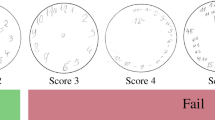Abstract
The prevalence of dementia is currently increasing worldwide. This syndrome produces a deterioration in cognitive function that can not be reverted. However, an early diagnosis can be crucial for slowing its progress. The Clock Drawing Test (CDT) is a widely used paper-and-pencil test for cognitive assessment in which an individual has to manually draw a clock on a paper during a certain time. Nevertheless, there are a lot of scoring systems for this test and most of them depend on the subjective assessment of the expert. This study proposes a computer-aided diagnosis (CAD) system based on deep learning in order to automate the diagnosis of cognitive impairment (CI) from the result of the CDT. This is addressed by employing a preprocessing pipeline in which the clock is detected and centered, as well as binarized for decreasing the computational burden. Then, the resulting image is fed into a Convolutional Neural Network (CNN), which is used to identify the informative patterns within the CDT drawings that are relevant for the assessment of the patient’s cognitive status. Performance is evaluated in a real context where differentiating between CI patients and controls. The proposed method provides an accuracy of 68.62% in this classification task, with an AUC of 74.53%. A validation method using resubstitution with upper bound correction is also discussed.
Access this chapter
Tax calculation will be finalised at checkout
Purchases are for personal use only
Similar content being viewed by others
References
Amini, S., et al.: An artificial intelligence-assisted method for dementia detection using images from the clock drawing test. J. Alzheimer’s Dis. 83(2), 581–589 (2021). https://doi.org/10.3233/JAD-210299
Binaco, R., et al.: Machine learning analysis of digital clock drawing test performance for differential classification of mild cognitive impairment subtypes versus Alzheimer’s disease. J. Int. Neuropsychol. Soc. 26(7), 690–700 (2020). https://doi.org/10.1017/s1355617720000144
Chan, J.Y.C., et al.: Evaluation of digital drawing tests and paper-and-pencil drawing tests for the screening of mild cognitive impairment and dementia: a systematic review and meta-analysis of diagnostic studies. Neuropsychol. Rev. 1–11 (2021). https://doi.org/10.1007/s11065-021-09523-2
Chen, S., Stromer, D., Alabdalrahim, H.A., Schwab, S., Weih, M., Maier, A.: Automatic dementia screening and scoring by applying deep learning on clock-drawing tests. Sci. Rep. 10(1), 1–11 (2020). https://doi.org/10.1038/s41598-020-74710-9
Davoudi, A., et al.: Classifying non-dementia and Alzheimer’s disease/vascular dementia patients using kinematic, time-based, and visuospatial parameters: the digital clock drawing test. J. Alzheimer’s Dis. 82(1), 47–57 (2021). https://doi.org/10.3233/JAD-201129
Freedman, M., Leach, L., Kaplan, E., Winocur, G., Shulman, K., Delis, D.C.: Clock Drawing: A Neuropsychological Analysis. Oxford University Press, USA (1994)
Górriz, J.M., et al.: Artificial intelligence within the interplay between natural and artificial computation: advances in data science, trends and applications. Neurocomputing 410, 237–270 (2020)
Górriz, J.M., Ramirez, J., Suckling, J.: On the computation of distribution-free performance bounds: application to small sample sizes in neuroimaging. Pattern Recognit. 93, 1–13 (2019). https://doi.org/10.1016/j.patcog.2019.03.032
Huang, G., Liu, Z., Van Der Maaten, L., Weinberger, K.Q.: Densely connected convolutional networks. In: Proceedings of the IEEE Conference on Computer Vision and Pattern Recognition, pp. 4700–4708 (2017)
Jimenez-Mesa, C., et al.: Optimized one vs one approach in multiclass classification for early Alzheimer’s disease and mild cognitive impairment diagnosis. IEEE Access 8, 96981–96993 (2020). https://doi.org/10.1109/access.2020.2997736
Knopman, D.S., et al.: Alzheimer disease. Nat. Rev. Dis. Primers 7(1), 1–21 (2021). https://doi.org/10.1038/s41572-021-00269-y
Müller, S., Preische, O., Heymann, P., Elbing, U., Laske, C.: Increased diagnostic accuracy of digital vs. conventional clock drawing test for discrimination of patients in the early course of Alzheimer’s disease from cognitively healthy individuals. Front. Aging Neurosci. 9, 101 (2017). https://doi.org/10.3389/fnagi.2017.00101
Ortiz, A., Munilla, J., Górriz, J.M., Ramírez, J.: Ensembles of deep learning architectures for the early diagnosis of the Alzheimer’s disease. Int. J. Neural Syst. 26(07), 1650025 (2016). https://doi.org/10.1142/s0129065716500258
Palsetia, D., Rao, G.P., Tiwari, S.C., Lodha, P., De Sousa, A.: The clock drawing test versus mini-mental status examination as a screening tool for dementia: a clinical comparison. Ind. J. Psychol. Med. 40(1), 1–10 (2018)
Sandler, M., Howard, A., Zhu, M., Zhmoginov, A., Chen, L.C.: Mobilenetv2: inverted residuals and linear bottlenecks. In: Proceedings of the IEEE Conference on Computer Vision and Pattern Recognition, pp. 4510–4520 (2018)
Schölkopf, B., Smola, A.J., Bach, F., et al.: Learning with Kernels: Support Vector Machines, Regularization, Optimization, and Beyond. MIT Press, Cambridge (2002)
Shulman, K.I.: Clock-drawing: is it the ideal cognitive screening test? Int. J. Geriatr. Psychiatry 15(6), 548–561 (2000). https://doi.org/10.1002/1099-1166(200006)15:6<548::aid-gps242>3.0.co;2-u
Srivastava, N., Hinton, G., Krizhevsky, A., Sutskever, I., Salakhutdinov, R.: Dropout: a simple way to prevent neural networks from overfitting. J. Mach. Learn. Res. 15(1), 1929–1958 (2014)
Vapnik, V., Levin, E., Cun, Y.L.: Measuring the VC-dimension of a learning machine. Neural Comput. 6(5), 851–876 (1994)
Wold, S., Ruhe, A., Wold, H., W. J. Dunn, I.: The collinearity problem in linear regression. The partial least squares (PLS) approach to generalized inverses. SIAM J. Sci. Stat. Comput. 5(3), 735–743 (1984). https://doi.org/10.1137/0905052
Acknowledgments
This work was supported by the MCIN/ AEI/10.13039/501100011033/ and FEDER “Una manera de hacer Europa” under the RTI2018-098913-B100 project, by the Consejeria de Economia, Innovacion, Ciencia y Empleo (Junta de Andalucia) and FEDER under CV20-45250, A-TIC-080-UGR18, B-TIC-586-UGR20 and P20-00525 projects, and by the Ministerio de Universidades under the FPU18/04902 grant given to C. Jimenez-Mesa and the Margarita-Salas grant to J.E. Arco
Author information
Authors and Affiliations
Corresponding author
Editor information
Editors and Affiliations
Rights and permissions
Copyright information
© 2022 Springer Nature Switzerland AG
About this paper
Cite this paper
Jiménez-Mesa, C. et al. (2022). Automatic Classification System for Diagnosis of Cognitive Impairment Based on the Clock-Drawing Test. In: Ferrández Vicente, J.M., Álvarez-Sánchez, J.R., de la Paz López, F., Adeli, H. (eds) Artificial Intelligence in Neuroscience: Affective Analysis and Health Applications. IWINAC 2022. Lecture Notes in Computer Science, vol 13258. Springer, Cham. https://doi.org/10.1007/978-3-031-06242-1_4
Download citation
DOI: https://doi.org/10.1007/978-3-031-06242-1_4
Published:
Publisher Name: Springer, Cham
Print ISBN: 978-3-031-06241-4
Online ISBN: 978-3-031-06242-1
eBook Packages: Computer ScienceComputer Science (R0)




